|
In kite surfing /
kite boarding the steering bar allowes the surfer to control the motion
/ flight of the kite and connects the kite surfer to the kite. The bar
is moved in an left/up and right / down motion ( or some call it boxing
) or opposite by the surfer to steer the kite left or right .
The inner lines ( break lines / flight lines / power lines) are
attached to the harness via chicken loop and by pushing the bar away
from the surfer he can depower the kite. This setup would be tiering
over time on our kite-sailer.
As such we need to change this setup to a more comfortable moition. Our
kite control bar will direct the forces of the inner lines ( the power
lines / break lines / flight lines) to the hull via a 1:2
reduction with quick release. The outer lines ( steering lines / flying
lines) will be 90 degree redirected to the controller handle bar
which has a left-forward / right-aft ( or opposite) motion to steer the
kite actively from a sitting position on the kite-sailer.
Since the kite-sailer kite control bar will be used on a boat and its
intention is to use it for extended periods of time, in a saltwater
environment, all components used are marine grade stainless steel and
can handle the loads of modern traction kites. Safe working load was
set at excess of 500lb .
kit
Back to main page.
|
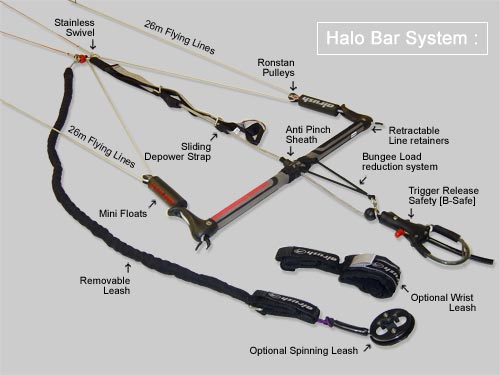 |
|
The "Wind Window" and forces of the kite :
align="left"> I want to add
this short explanation for all who are coming from boating / sailing to
this site and are not familiar with the expression "wind window" and
the forces behind it. Kite surfer are well familiar with the forces and
master them to their benefit.
The "wind window" as seen on the right side is if you are standing with
your back into the wind ( upwind ) and face away from the wind (
downwind) . The 3-dimensional area in front of you and within the reach
of your kite - kind of limited by the length of the kite lines which
are normally about 20 meter / 64 feet. Each section of the "wind
window" has a different force on the kite , different acceleration of
the kite and diffrent pull / lift characteristics. The upwind section
of the "wind-window" or for sailor the circle of "Beam reach " has the
lowest amount of force / lift / pull and the slowest motion of the
kite. As you steer your kite into the center of the "wind window" or
downwind / run the forces will increase drastically as well as the
speed of the kite as it is moving through your wind window. To balance
the motion and the forces of the kite through the "wind window"
requires an open area in front of your kite to hull attachment point as
well as a free space for the kite controller to maneuver the kite
control lines, besides attention and quick reaction so you don't ditch
your kite in the water.
As you actively steer your kite through the wind window you can make
use of the diffrence between pulling forces and lifting forces to
balance your hull with the motion of your kite.
Back to main page.
|
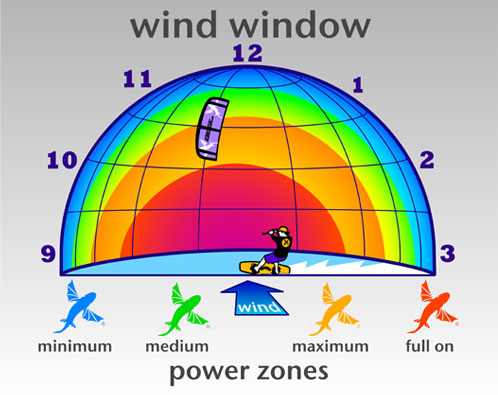 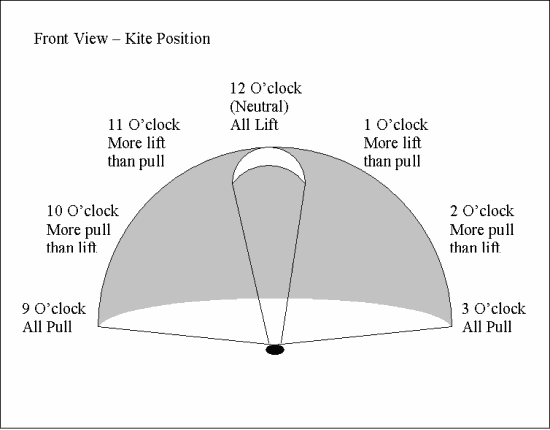 |
|
Connecting the kite to the hull
Most modern
traction kites are 4 line kites - this results into 2 power lines at
the kite and 2 steering lines. The power lines are more to the center /
forward of the kite while the steering lines are aft / on the trailing
edge of the kite.
The power lines can be connected at the hull into one line - while the
2 steering lines need to stay independent from each other for control.
Power lines need to be easy adjusted for setting the kite canopy angle
for your convenience and in case of a emergency to be depowered - (
released) which results in a airfoil shape with 0 lift.
You can accomplish this with a pulley on a line leading back to a cam
cleat at the same location where you will steer the kite.
Steering lines need to be able to adjust ( via a bar ) or any other
means to pull or release. This will steer your kite and fly him through
the power window in a controlled manner -
The image on the right is from a Airrush one 4 line kite with only one
bladder and steering lines well apart from the power lines - I believe
for us a bit slower moving kite-boater this set up is better than the
older C-shape kites where power lines and steering line attachemnt
points are within 8 "
I hope I could help you understand the basic setup for kite boating -
if you have any question feel free to ask michael@4wings.com
Back to
main page.
|
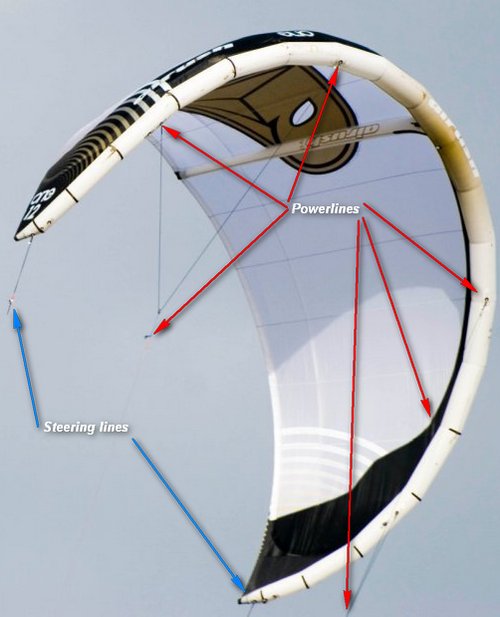 |
|
May -
A new set of pulleys came in
and they fit great - low weight / swivel head and ball bearings in our
working load range -
This is the core of a long discussion we had when we tried to find the
best suitable lines for the kite-sailer control bar.
For kite control lines you need lines with low diameter ( to hold drag
low ) , low weight and high "Tensile Strength"
On the control bar you will need high tensile strength but can be
more flexible on the diameter.
Tensile strength is the load at which a new rope / line , tested under
laboratory conditions, can be expected to break.
Safe working load of a rope / line is determined by dividing the
minimum tensile strength by the safety factor .
Safety factors range from 5 to 12 for non critical uses. The safe
working load is a guideline for rope/line in good condition.
With age and use, the safe working load of your kite
rope / line will get lower.
So lets get out of the theory and start to look at the Kite lines and
control bar lines -
Currently common kite lines are "Dyneema SK75-12" or "Dyneema sk90"
Alternatively you can use :
"Spectra"which is used by some kite manufacturer and
"Vectran"
"Spectra" and "Dyneema" are the same material
Ultra-high-molecular-weight polyethylene , just different trade names
and the manufacturing process is different.
"Vectrans" are some form of liquid crystal polymer that have similar
strength, but higher modulus and less creep. for more detail please see
:
http://www.performancedesigns.com/hma.asp
If you are in the EU / Asia
you might look into Liros lines : http://www.liros.com/start.aspx
Kevlar ( aramid) fibers are
still as strong as spectra but higher in density.
You'll frequently see fibers compared with strength / weight as the
ultimate value.
But this is not necessarily stronger, but stronger per unit weight as
such you need to make the numbers till the end ....
Diameter and tensile strength of Dyneema SK75-12
Avg. Tensile strength for 1.8 mm - 920 lbs
Avg. Tensile strength for 2mm - 1000 lbs
Avg. Tensile strength for 3mm - 1920 lbs
For most user the kite lines provided by the kite manufacturer will be
your best choice - as one of the main problem is to find a supplier who
has the quality you need , the diameter you desire - in the colors you
want at a price you can afford ...lol in a line diameter of 3 mm and up
you will find a small amount of supplier - unfortunately that diameter
is a bit to high - you will try to be in the 1.5 mm to 1.8mm (
approximately 1/16" ) diameter
range of lines for your flying lines -
For your kite control bar the lines can be in the 3mm ( approx. 1/8"
) and 6 mm ( approx. 1/4") range as these lines are not all too
much subject to drag but quite some chaffing.
All the lines should be eye spliced to hold the maximum breaking
load throughout the entire line which is possible on the 6mm up lines
but hard on anything below this diameter.
The only supplier we found who actually carried more than one color and
diameter was : http://www.milwaukeerigging.com/index.htm
But we hope that over time we will
have more suppliers for you
Back to main page
|
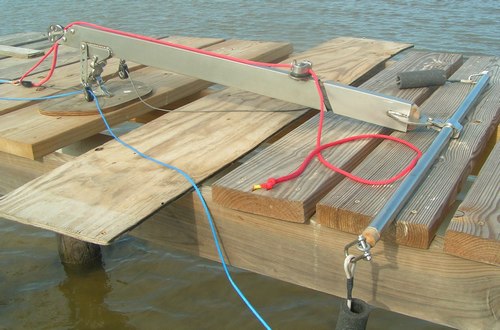
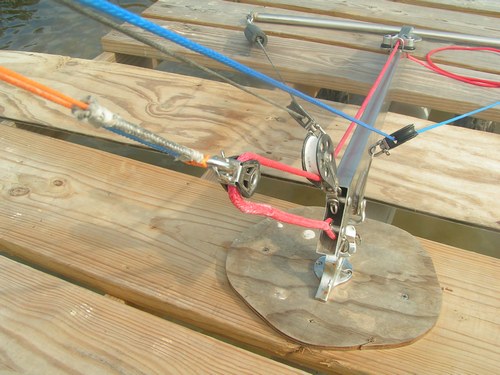
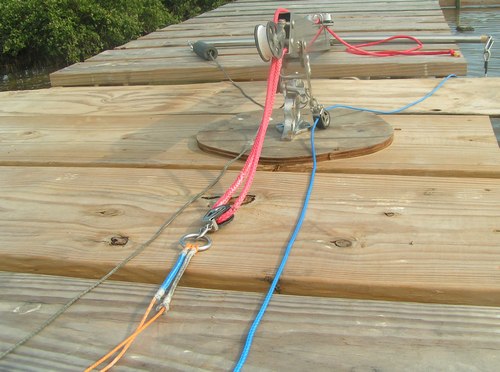
|
|
April -
We get most of the components
ready to go into the first test trial - test were performed at our dock
with a 3.5 meter trainer kite to get the basic feel for the bar - even
if the functions performed well - the pulleys were too big
and the lines too heavy - guess I have to get the sailor out of
me and rethink thin ...how thin ..?
Back to main page
|
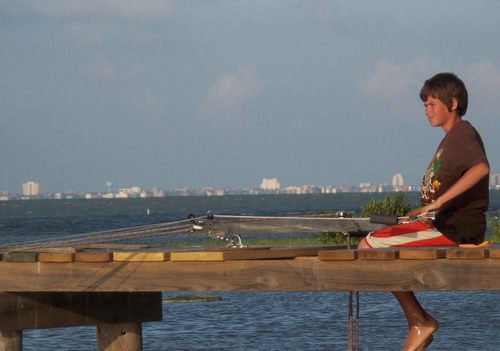 |
|
March -
Kite-sailer kite control bar
extended
Back to main page
|
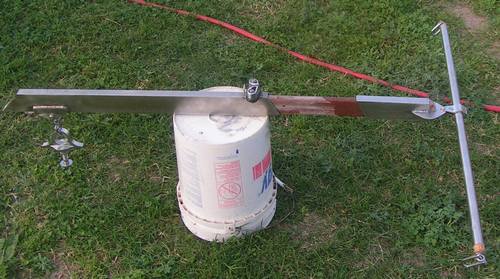 |
|
March -
Just out of the welding shop -
The basic components are a SS square bar with welded support for the
cam cleat on top which will serve as de-power system / de-power
adjuster.
The fork swiveling snap shackle serves as emergency release and
connects the handle bar to a lifting eye which is through-bolted the
boat hull and secured with a 5/8 SS bolt
A pivot point for the handle bar is welded to the outer piston sleeve
which will connect the outer ( steering ) lines.
Back to main page
© 2012
kite-sailer.com
|
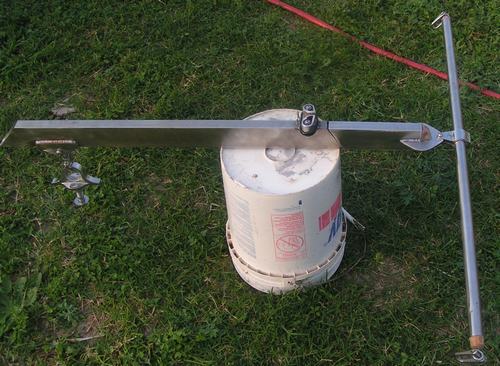 |








